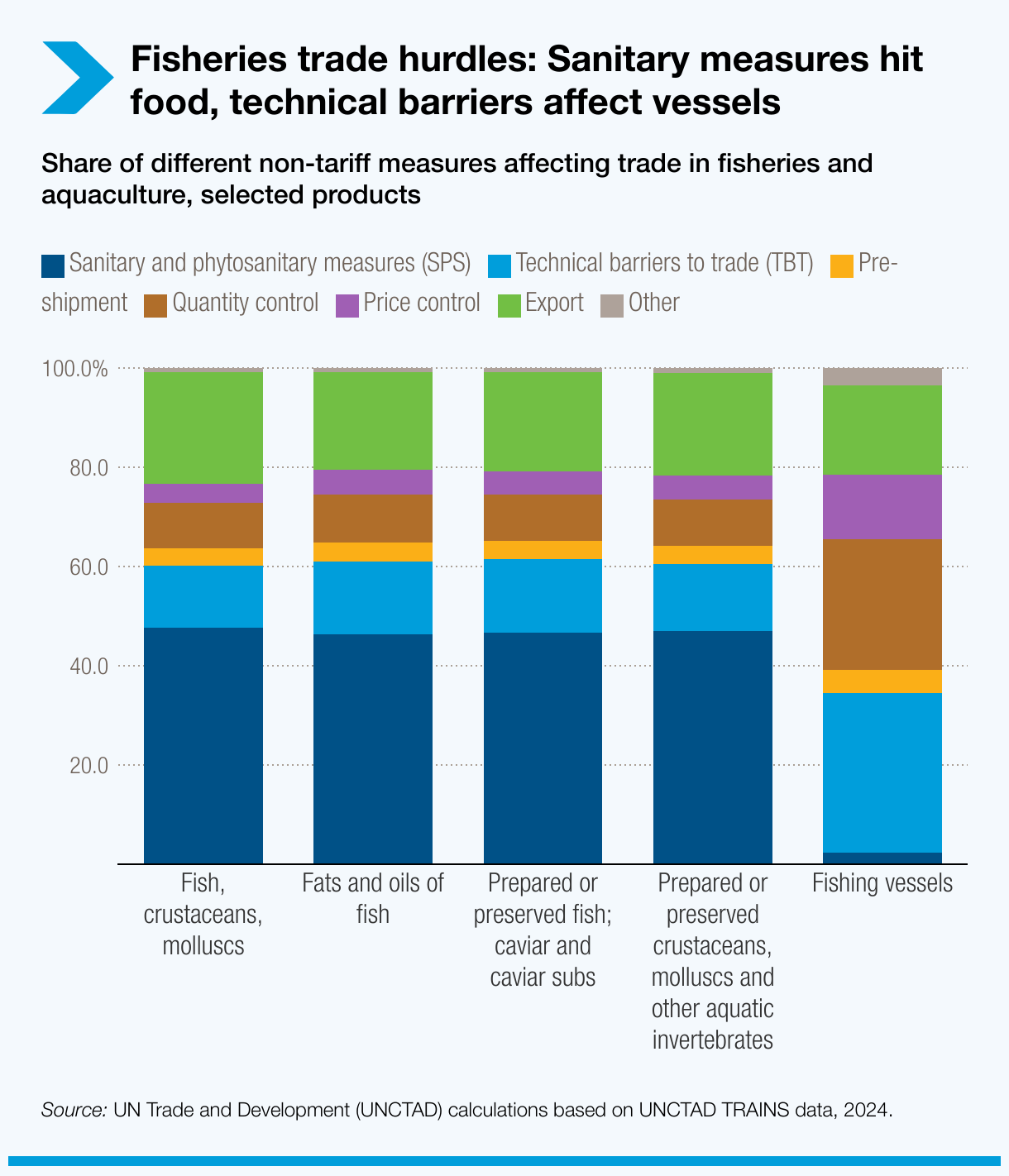Booming South-South trade in fisheries and aquaculture offers a sea of opportunities
Trade in the sector between developing countries has doubled over the past decade, but persistent barriers highlight the need to revitalize the global system of trade preferences among them to unlock further growth.

-
Global trade in marine fisheries and aquaculture hit $186 billion in 2022, up 63% from $114 billion in 2012.
-
South-South trade in the sector doubled over the same period, rising from $19 billion to $39 billion.
-
The sector faces challenges like overfishing, climate change and trade barriers, with non-tariff measures affecting 93% of imports for fish products.
Global trade in marine fisheries and aquaculture offers big opportunities for sustainable and inclusive economic growth while advancing key Sustainable Development Goals (SDGs), particularly improving food security and eliminating hunger (SDG 2) and protecting life below water (SDG 14).
The sector, including fish, crustaceans, molluscs, seaweed and many value-added aquatic by-products, saw global exports hit $186 billion in 2022, up 63% from $114 billion in 2012.
Notably, South-South trade – commerce between developing countries – has surged across various fisheries sectors, including marine fisheries, aquaculture, fish processing and fishing vessels. According to new UN Trade and Development (UNCTAD) analysis, this trade more than doubled from around $19 billion in 2012 to $39 billion in 2022.
Chile, China, Ecuador, India, Peru, Thailand and Vietnam are leading exporters among developing countries, which accounted for 46% of global seafood exports in 2022, up from 42% in 2012. Notably, their share of the higher-value processed segment is higher than that of unprocessed exports, at 53% compared with 40%.
“This highlights the success of developing countries in adding value to their seafood exports,” says David Vivas Eugui, in charge of UN Trade and Development’s ocean and circular economy section.
A new era of South-South trade
This growth in South-South trade in fisheries and aquaculture contrasts with traditional trade patterns, in which developing countries primarily export to advanced markets.
“This shift signifies a new era where developing countries are increasingly trading with each other,” Mr. Vivas Eugui says.
South-South trade, Mr. Vivas Eugui says, allows developing countries to retain more economic benefits locally, create jobs and foster innovation in both food and non-food marine-based products. In the fisheries and aquaculture sectors, it also improves food security and increases access to protein-rich foods, particularly for coastal populations.
By trading more with each other, developing countries can add value to their products while enhancing quality or processing before export.
Mr. Vivas Eugui says this not only boosts local industries but also strengthens their capacity to compete internationally, including in advanced markets.
Competitive advantage of developing countries
UN Trade and Development’s Revealed Comparative Advantage analysis measures a country’s export performance relative to its global trade. It reveals that many developing countries have a comparative edge in various marine species and by-products. Examples include:
- Mozambique excels in exporting rock lobsters and other sea crawfish.
- Argentina is renowned for frozen hake, prized globally for its firm texture and mild flavour.
- Morocco stands out with processed sardines, benefiting from rich marine biodiversity and sustainable fishing practices.
- Peru thrives in exporting prepared or preserved anchovies, tapping into the abundant, nutrient-rich fish stocks of the Humboldt Current.
These advantages allow these countries to capitalize on specific markets, driving economic growth and diversifying exports.
Additionally, fisheries and aquaculture are linked to the creative economy, with chefs in many developing countries expressing their creativity through the use of local species and rich, biodiverse flavours.
Climate change, overfishing and non-tariff measures pose big challenges
Despite the promising growth, the marine fisheries and aquaculture sector faces several challenges. Overfishing, harmful subsidies and climate change pose significant threats to sustainability.
Overfished stocks have tripled since 1974, with over one third of the world’s assessed fisheries currently overfished. Climate change exacerbates these issues, affecting sea temperatures and ecosystems, threatening both the environment and the livelihoods dependent on these resources.
Trade barriers, particularly non-tariff measures (NTMs), also hinder the growth. NTMs are rules and regulations, other than tariffs, that countries use to control the amount and types of products entering their markets. They include requirements for food safety and quality standards, which can be costly for exporters.
The Global System of Trade Preferences among Developing Countries (GSTP) is an agreement among developing countries to promote trade by offering preferential treatment in tariffs and other trade barriers. UN Trade and Development serves as the secretariat for this unique agreement on South-South trade and cooperation.
Despite lower tariffs among GSTP members, the prevalence of NTMs continues to pose obstacles to trade.
For instance, sanitary and phytosanitary measures (SPS) and technical barriers to trade (TBT) significantly increase compliance costs and restrict market access. They account for about 65% of all NTMs faced by exporters (50% for SPS and 15% for TBT). For imports, SPS measures affect 93% of import relationships for fish and fish products, while TBTs affect 82%.
The GSTP’s potential as a platform for change
In 2022, GSTP members accounted for more than 60% of developing countries’ total exports in the sector, illustrating the agreement’s vital role in fostering South-South trade.
With 42 members across Africa, Asia and Latin America, the GSTP covers 4 billion people, offering vast potential and diverse markets.
“It provides a unique platform for addressing these challenges by fostering cooperation among developing countries,” says Chantal Line Carpentier, head of UN Trade and Development’s trade, environment, climate change and sustainable development branch.
Harmonizing and reducing NTMs through the GSTP can make it easier for developing countries to access regional and global markets, thus helping them integrate into global value chains and preparing their businesses for international competition.
Ms. Carpentier adds that the GSTP also allows participants to leverage their strengths in specific marine products, fostering a diversified and resilient trade environment.
UN Trade and Development calls for revitalizing the GSTP to unlock further potential in South-South trade across many sectors, which could increase trade flows, improve food security and promote sustainable economic development.
Source : UNCTAD






